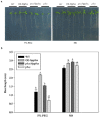Functional Characterization of the Stipa purpurea P5CS Gene under Drought Stress Conditions
- PMID: 34502515
- PMCID: PMC8431763
- DOI: 10.3390/ijms22179599
Functional Characterization of the Stipa purpurea P5CS Gene under Drought Stress Conditions
Abstract
Free proline has multiple functions in plant cells, such as regulating osmotic potential and protecting both proteins and cell membranes. The expression of Δ1-Pyrroline-5-carboxylate synthase (P5CS), a key enzyme in the proline biosynthetic pathway, increases under drought, salt and cold stress conditions, causing plant cells to accumulate large amounts of proline. In this study, we cloned and identified the P5CS gene from Stipa purpurea, which has a full-length of 2196 bp and encodes 731 amino acids. A subcellular localization analysis indicated that SpP5CS localized to the cytoplasm. The ectopic overexpression of SpP5CS in Arabidopsis thaliana resulted in higher proline contents, longer roots, higher survival rates and less membrane damage under drought stress conditions compared with wild-type controls. SpP5CS-overexpressing A. thaliana was more resistant to drought stress than the wild type, whereas the deletion mutant sp5cs was less resistant to drought stress. Thus, SpP5CS may be a potential candidate target gene for increasing plant resistance to drought stress.
Keywords: P5CS; Stipa purpurea; drought tolerance; proline.
Conflict of interest statement
The authors declare no conflict of interest.
Figures






References
-
- Geng G., Wu J., Wang Q., Lei T., He B., Li X., Mo X., Luo H., Zhou H., Liu D. Agricultural drought hazard analysis during 1980–2008: A global perspective. Int. J. Climatol. 2016;36:389–399. doi: 10.1002/joc.4356. - DOI
-
- Hassan N., El-bastawisy Z., Ebeed H., Nemat Alla M.N. Role of defense enzymes, proteins, solutes and Δ1-pyrroline-5-carboxylate synthase in wheat tolerance to drought. Rend. Fis. Acc. Lincei. 2015;26:281–291. doi: 10.1007/s12210-015-0429-y. - DOI
-
- Ebeed H.T., Hassan N.M., Keshta M.M., Hassanin O.S. Comparative analysis of seed yield and biochemical attributes in different sunflower genotypes under different levels of irrigation and salinity. Egypt. J. Bot. 2019;59:339–355. doi: 10.21608/ejbo.2019.5043.1205. - DOI
MeSH terms
Substances
Grants and funding
- 41771123/National Natural Science Foundation of China
- 32070362/National Natural Science Foundation of China
- 202101AT070190/Yunnan Fundamental Research Projects
- 202002AA100007/Digitalization, Development and Application of Biotic Resource
- KFJ-FP-201905/poverty alleviation through science and technology projects of Chinese Academy of Sciences
LinkOut - more resources
Full Text Sources
Miscellaneous

